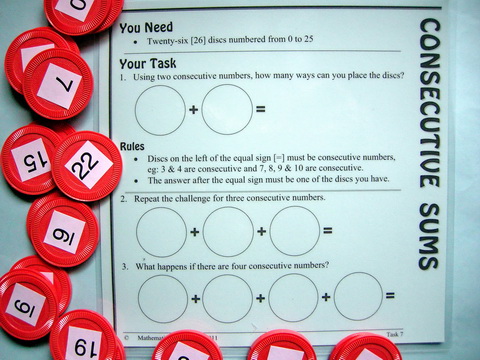
Consecutive SumsTask 7 ... Years 4 - 8SummaryProblem: Given number discs from 0 to 25, how many ways can you build addition equations with consecutive numbers as addends and the total among the discs?
|
Materials
Content
|

IcebergA task is the tip of a learning iceberg. There is always more to a task than is recorded on the card. |
There are two critical elements in this task:
The task only asks students how many solutions they can find; it doesn't ask to find them all. However encouraging them with questions like: Great, you've found three ways so far. Do you think there might me more? ... Look at the mathematicians' questions on your Working Mathematically page. Which ones do you think a mathematician would ask now?can lead to collecting more data and listing or tabulating it. For example for two addends: 25:(12, 13)Digging Deeper
|
Whole Class InvestigationTasks are an invitation for two students to work like a mathematician. Tasks can also be modified to become whole class investigations which model how a mathematician works. |
The whole class lesson for this task is detailed in Maths300 Lesson 139, Consecutive Sums. To convert the task to a whole class lesson each student cuts or tears a piece of paper into 16 sections. This is easy folding and gives enough pieces per pair for the numbers 0 - 25 with some left over for + and = signs. You will find that with most classes these are soon abandoned in favour of scrapbook work with written numbers, but without the pieces some students may not become engaged in the problem in the first place. For more ideas and discussion about this investigation, open a new browser tab (or page) and visit Maths300 Lesson 139, Consecutive Sums, which also includes a Poster Puzzle to stimulate the investigation. |
Is it in Maths With Attitude?Maths With Attitude is a set of hands-on learning kits available from Years 3-10 which structure the use of tasks and whole class investigations into a week by week planner. |
The Consecutive Sums task is an integral part of:
The Consecutive Numbers lesson is an integral part of:
|